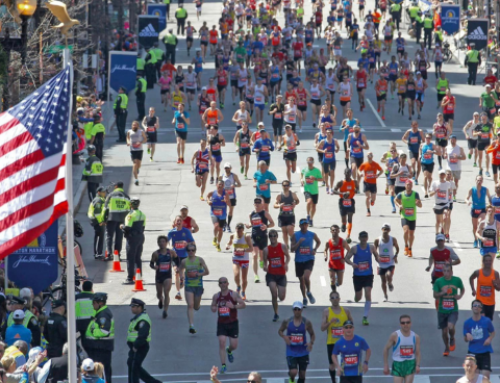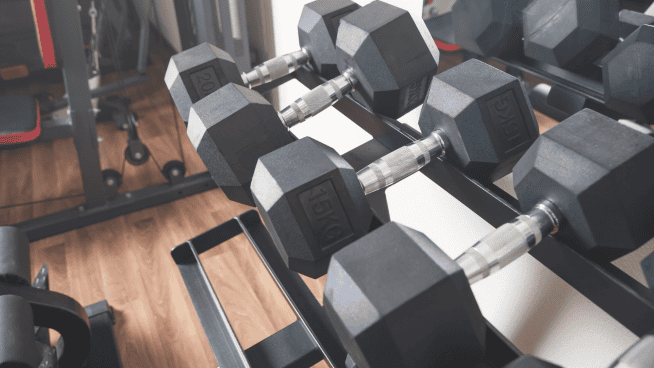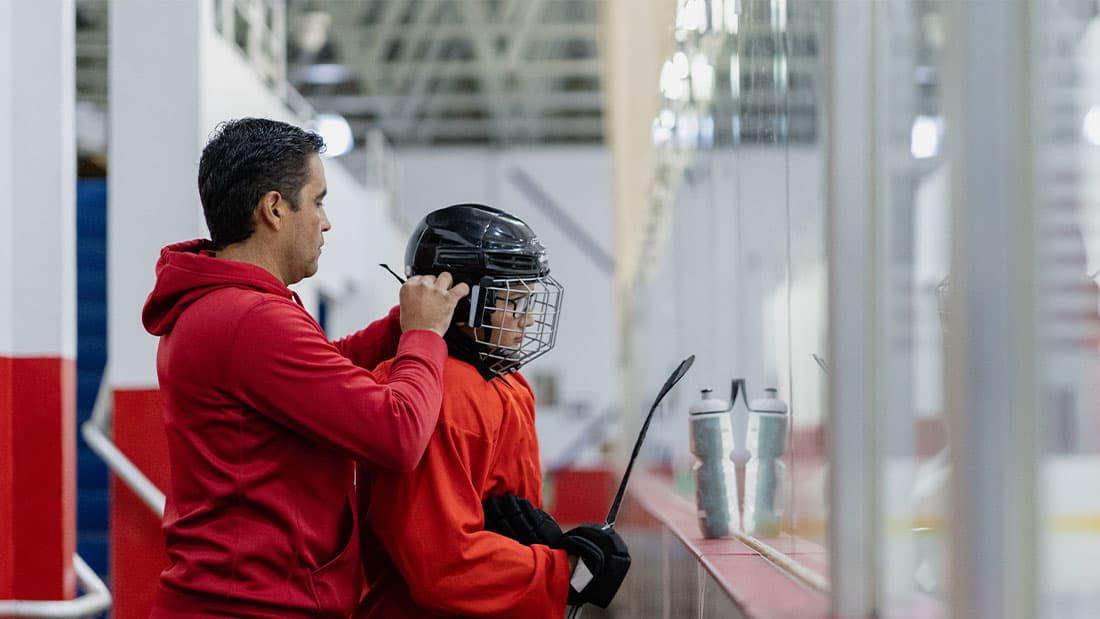When you work out, you need to get as much done as possible in the limited amount of time you have to train. Below are 11 tips and strategies that will make your workouts more efficient and effective.
1. Preview Your Workout
Before you even step into the weight room, take a look at your workout. Review the exercises on your schedule and form a mental plan of what you need to do. If your gym is crowded, make adjustments based on equipment availability. The last thing you want to do walk around aimlessly, unsure of what to do next.
2. Wear a Watch
Wearing a watch keeps you honest. Glancing at the amount of time you have left helps you keep your workout on schedule. You won’t waste any time resting for more than you need to between sets.
3. Bring a Water Bottle
Carrying your own water bottle eliminates time-wasting trips to the water fountain. Plus, you can hydrate properly throughout your workout without exposing yourself to germs from the water fountains.
4. Put Your Phone on “Do Not Disturb”
Receiving a text or call mid-workout can throw off your schedule and add unnecessary time to your workout. Unless it’s an emergency, wait to reply until you finish.
5. Don’t Go Crazy With Your Warm-Up
You only need 10 minutes to warm up. That’s it. Anything more cuts into your workout. If you have a packed warm-up agenda, especially if you plan to foam roll all of your major muscles, do your foam rolling at home beforehand or even earlier in the day. Warming up your body, activating your muscles and increasing your range of motion are the priorities. Here’s a simple warm-up template you can follow.
6. Use Supersets
Supersets save time. You work two muscle groups in the same amount of time it would take to perform one move and recover. With supersets, you don’t rest between sets. One muscle (e.g., your triceps) recovers while you work another muscle (e.g., your biceps). You can pair virtually any two exercises (e.g., Squats and Push-Ups) as long as they don’t work the same muscles. But for best results, superset exercises that work opposing muscle groups (e.g., Push-Ups [chest] and Inverted Rows [back]). Check out this article to learn the best supersets for athletes.
7. Integrate PAP Complexes
Traditionally, workouts call for plyos to be performed before strength exercises. With a PAP complex, you integrate the two. Perform a heavy strength move immediately followed by a plyometric drill that works the same movement pattern (e.g., a Squat and a Box Jump). This condenses your workout and actually increases your power gains.
8. Stretch Between Sets
As long as you’re not going for a PR on a lift, you can make better use of your recovery time by stretching between sets. In the video above, STACK Expert Mike Boyle recommends adding a stretch to a superset to form a tri-set. He recommends selecting a stretch that will enhance mobility on one of the superset exercises. In his example, he demonstrates pairing Goblet Split-Squats with Push-Ups and finishing with a Half-Kneeling Hip Flexor Stretch, which will improve your Goblet Split-Squat. Another benefit? Stretching allows you to recover between sets if you’re lifting heavy.
9. Try Complexes
A complex is a series of exercises that flow well together performed one after another. Since they involve several moves, complexes hit your entire body, enhancing both your strength and endurance. You can only use as much weight as your weakest lift in the group. But you’ll be torched after performing several sets of multiple exercises with little or no rest. Here’s how you can create your own complexes.
10. Limit Isolation Exercises
Isolation exercises (e.g., Bicep Curls and Leg Extensions) hit only one muscle group at a time. If you did nothing but isolation exercises, you’d be in the gym for hours working all the muscle groups you need to get an effective workout. It’s OK to do a few isolation moves toward the end of your workout—ideally in superset fashion—but the bulk of your workout should feature compound lifts. Squats, Deadlifts, Bench Presses and Pull-Ups work multiple muscle groups, making better use of your time. And they are simply better, more effective exercises to build strength and power.
11. Save Cardio For Another Day
If cardio has been part of your routine but you only have an hour to train, focus on your strength work first. A long cardio session can cut into your strength gains, yielding fewer benefits to your athletic performance (and even your physique [if that’s your goal]) than a complete weight lifting session designed to increase strength and build lean muscle. If you’re compelled to do cardio, do something that takes less time—e.g., a Tabata workout. Or, just save cardio for a day when you’re not lifting.
RECOMMENDED FOR YOU
MOST POPULAR
When you work out, you need to get as much done as possible in the limited amount of time you have to train. Below are 11 tips and strategies that will make your workouts more efficient and effective.
1. Preview Your Workout
Before you even step into the weight room, take a look at your workout. Review the exercises on your schedule and form a mental plan of what you need to do. If your gym is crowded, make adjustments based on equipment availability. The last thing you want to do walk around aimlessly, unsure of what to do next.
2. Wear a Watch
Wearing a watch keeps you honest. Glancing at the amount of time you have left helps you keep your workout on schedule. You won’t waste any time resting for more than you need to between sets.
3. Bring a Water Bottle
Carrying your own water bottle eliminates time-wasting trips to the water fountain. Plus, you can hydrate properly throughout your workout without exposing yourself to germs from the water fountains.
4. Put Your Phone on “Do Not Disturb”
Receiving a text or call mid-workout can throw off your schedule and add unnecessary time to your workout. Unless it’s an emergency, wait to reply until you finish.
5. Don’t Go Crazy With Your Warm-Up
You only need 10 minutes to warm up. That’s it. Anything more cuts into your workout. If you have a packed warm-up agenda, especially if you plan to foam roll all of your major muscles, do your foam rolling at home beforehand or even earlier in the day. Warming up your body, activating your muscles and increasing your range of motion are the priorities. Here’s a simple warm-up template you can follow.
6. Use Supersets
Supersets save time. You work two muscle groups in the same amount of time it would take to perform one move and recover. With supersets, you don’t rest between sets. One muscle (e.g., your triceps) recovers while you work another muscle (e.g., your biceps). You can pair virtually any two exercises (e.g., Squats and Push-Ups) as long as they don’t work the same muscles. But for best results, superset exercises that work opposing muscle groups (e.g., Push-Ups [chest] and Inverted Rows [back]). Check out this article to learn the best supersets for athletes.
7. Integrate PAP Complexes
Traditionally, workouts call for plyos to be performed before strength exercises. With a PAP complex, you integrate the two. Perform a heavy strength move immediately followed by a plyometric drill that works the same movement pattern (e.g., a Squat and a Box Jump). This condenses your workout and actually increases your power gains.
8. Stretch Between Sets
As long as you’re not going for a PR on a lift, you can make better use of your recovery time by stretching between sets. In the video above, STACK Expert Mike Boyle recommends adding a stretch to a superset to form a tri-set. He recommends selecting a stretch that will enhance mobility on one of the superset exercises. In his example, he demonstrates pairing Goblet Split-Squats with Push-Ups and finishing with a Half-Kneeling Hip Flexor Stretch, which will improve your Goblet Split-Squat. Another benefit? Stretching allows you to recover between sets if you’re lifting heavy.
9. Try Complexes
A complex is a series of exercises that flow well together performed one after another. Since they involve several moves, complexes hit your entire body, enhancing both your strength and endurance. You can only use as much weight as your weakest lift in the group. But you’ll be torched after performing several sets of multiple exercises with little or no rest. Here’s how you can create your own complexes.
10. Limit Isolation Exercises
Isolation exercises (e.g., Bicep Curls and Leg Extensions) hit only one muscle group at a time. If you did nothing but isolation exercises, you’d be in the gym for hours working all the muscle groups you need to get an effective workout. It’s OK to do a few isolation moves toward the end of your workout—ideally in superset fashion—but the bulk of your workout should feature compound lifts. Squats, Deadlifts, Bench Presses and Pull-Ups work multiple muscle groups, making better use of your time. And they are simply better, more effective exercises to build strength and power.
11. Save Cardio For Another Day
If cardio has been part of your routine but you only have an hour to train, focus on your strength work first. A long cardio session can cut into your strength gains, yielding fewer benefits to your athletic performance (and even your physique [if that’s your goal]) than a complete weight lifting session designed to increase strength and build lean muscle. If you’re compelled to do cardio, do something that takes less time—e.g., a Tabata workout. Or, just save cardio for a day when you’re not lifting.











